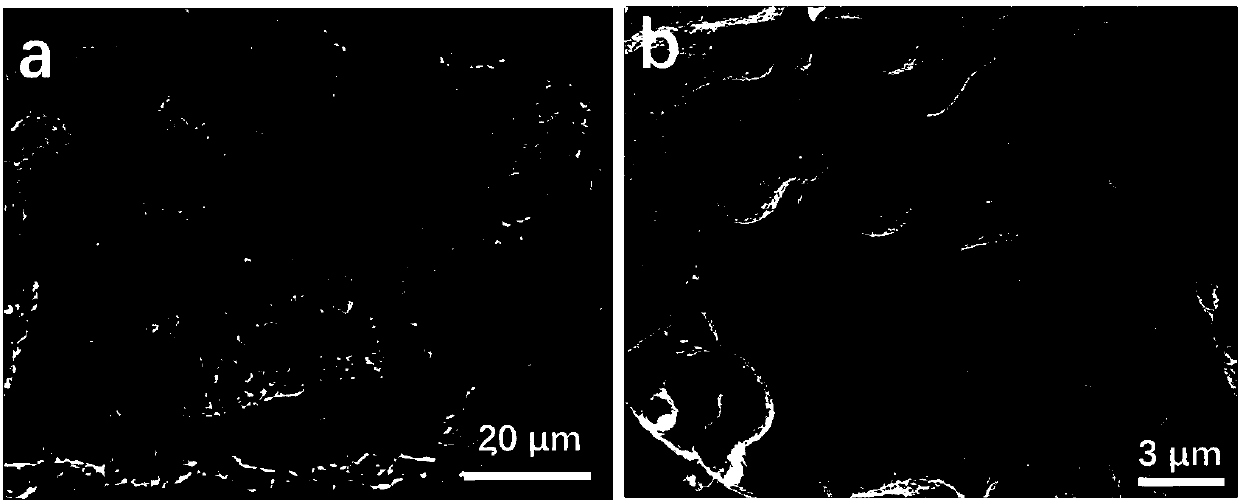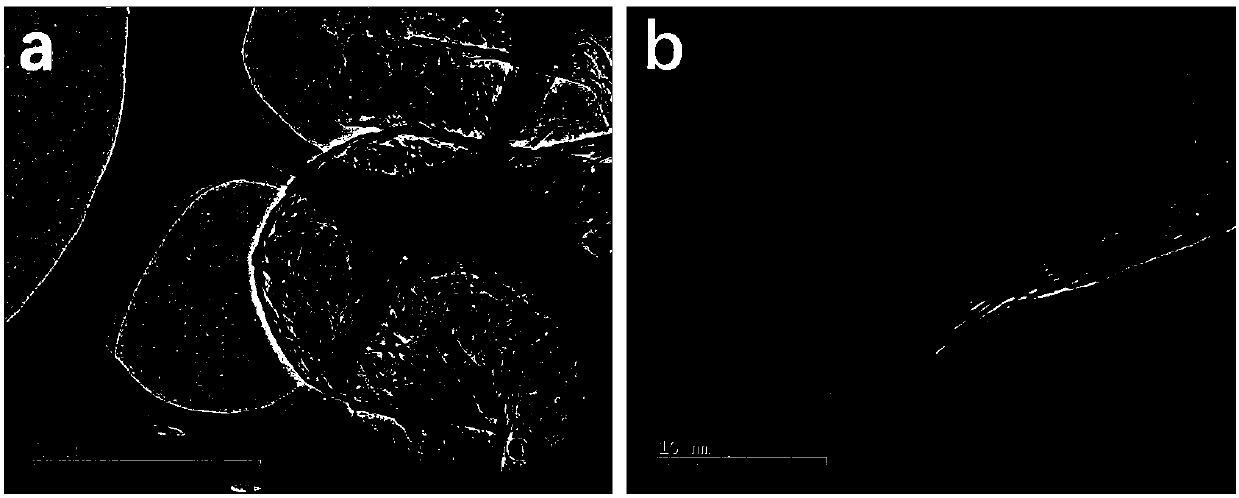Three-dimensional porous copper/graphene composite current collector for secondary metal lithium battery negative pole
A graphene composite, three-dimensional porous technology, applied in the direction of secondary batteries, electrode carriers/current collectors, battery electrodes, etc., can solve the problems of lithium dendrite generation, low cycle coulombic efficiency, etc., to suppress the generation of lithium dendrites, Simple process, inhibited growth effect
- Summary
- Abstract
- Description
- Claims
- Application Information
AI Technical Summary
Problems solved by technology
Method used
Image
Examples
Embodiment 1
[0024] (1) Preparation of nanoporous copper. Cu with a thickness of 100 μm was selected 30 mn 70 Alloy foil and cut it to 1×1cm 2 size. Then immerse the alloy foil in a 0.05M hydrochloric acid solution, and carry out dealloying at room temperature for 60 minutes. After the end, the foil is sequentially washed with deionized water-alcohol, and then dried in a vacuum drying oven for 4 hours to obtain nano porous copper.
[0025] (2) Preparation of three-dimensional porous copper / graphene current collectors. Put nanoporous copper into the quartz ark, place the ark in the reaction tube furnace near the nozzle area, and feed argon and hydrogen, the gas ratio is Ar:H 2 =500:200 sccm. Raise the temperature of the tube furnace to 900°C. When the furnace temperature reaches 900°C, quickly move the quartz ark from the nozzle area to the constant temperature area in the middle of the reaction tube, and react at this temperature for 3 minutes. Then feed ammonia, acetylene, argon an...
Embodiment 2
[0030] The difference from Example 1 is: (2) preparing a three-dimensional porous copper / graphene current collector. Put nanoporous copper into the quartz ark, place the ark in the reaction tube furnace near the nozzle area, and feed argon and hydrogen, the gas ratio is Ar:H 2=500:200 sccm. Raise the temperature of the tube furnace to 900°C. When the furnace temperature reaches 900°C, quickly move the quartz ark from the nozzle area to the constant temperature area in the middle of the reaction tube, and react at this temperature for 3 minutes. Then pass through acetylene, argon and hydrogen, the gas ratio is C 2 h 2 :Ar:H 2 =30:50:500:200sccm, reacted under these conditions for 2 minutes. The rest are the same as in Embodiment 1, and will not be repeated here.
[0031] The obtained current collector has a three-dimensional through pore structure, and its pore diameter is in the range of 1.0-2.0 μm, but the distribution of graphene on its surface is not uniform.
Embodiment 3
[0033] The difference from Example 1 is: (2) preparing a porous copper / graphene current collector. Put nanoporous copper into the quartz ark, place the ark in the reaction tube furnace near the nozzle area, and feed argon and hydrogen, the gas ratio is Ar:H 2 =500:200 sccm. Raise the temperature of the tube furnace to 900°C. When the furnace temperature reaches 900°C, quickly move the quartz ark from the nozzle area to the constant temperature zone in the middle of the reaction tube, and react at this temperature for 0.5 minutes. Then pass through acetylene, argon and hydrogen, the gas ratio is C 2 h 2 :Ar:H 2 =5:500:200sccm, react under these conditions for 10 minutes. The rest are the same as in Embodiment 1, and will not be repeated here.
[0034] The obtained current collector has a three-dimensional through pore structure, and its pore diameter is in the range of 400-500nm.
PUM
| Property | Measurement | Unit |
|---|---|---|
| thickness | aaaaa | aaaaa |
Abstract
Description
Claims
Application Information
 Login to View More
Login to View More - R&D
- Intellectual Property
- Life Sciences
- Materials
- Tech Scout
- Unparalleled Data Quality
- Higher Quality Content
- 60% Fewer Hallucinations
Browse by: Latest US Patents, China's latest patents, Technical Efficacy Thesaurus, Application Domain, Technology Topic, Popular Technical Reports.
© 2025 PatSnap. All rights reserved.Legal|Privacy policy|Modern Slavery Act Transparency Statement|Sitemap|About US| Contact US: help@patsnap.com



